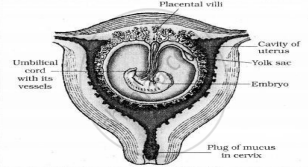Advertisements
Advertisements
प्रश्न
Explain the phases in embryonic development from the morula stage till the establishment of pregnancy in a human female.
उत्तर
- The embryo with 8 to 16 blastomeres is called a morula.
- The morula continues to divide and transforms into a blastocyst as it moves further into the uterus.
- The blastomeres in the blastocyst are arranged into an outer layer called trophoblast and An inner group of cells attached to the trophoblast is called the inner cell mass.
- The trophoblast layer then gets attached to the endometrium, and the inner cell mass gets differentiated as the embryo.
- After attachment, the uterine cells divide rapidly and cover the blastocyst.
- As a result, the blastocyst becomes embedded in the endometrium of the uterus. This is called implantation and it leads to pregnancy.

Fertilisation and passage of growing embryo in the fallopian tube.
APPEARS IN
संबंधित प्रश्न
During the reproductive cycle of a human female, when, where and how does a placenta develop? What is the function of placenta during pregnancy and embryo development?
Gonads develop from embryonic ______.
The first movements of the foetus and appearance of hair on its head are usually observed during which month of pregnancy?
In the event of pregnancy, the corpus luteum persists under the influence of ______.
In the development of the human body, the ectoderm is responsible for the formation of ______.
The concentration of which of the following substances will decrease in the maternal blood as it flows from embryo to placenta through the umbilical cord?

The human foetus within the uterus
- Oxygen
- Amino Acids
- Carbon dioxide
- Urea
The secondary sexual characters develop in females because:
Several hormones like HCG, HPL estrogen, and progesterone are produced by ______.
Explain the formation of placenta after the implantation in a human female.
The diagram given below represents a specific stage of human embryonic development. Identify the stage.

